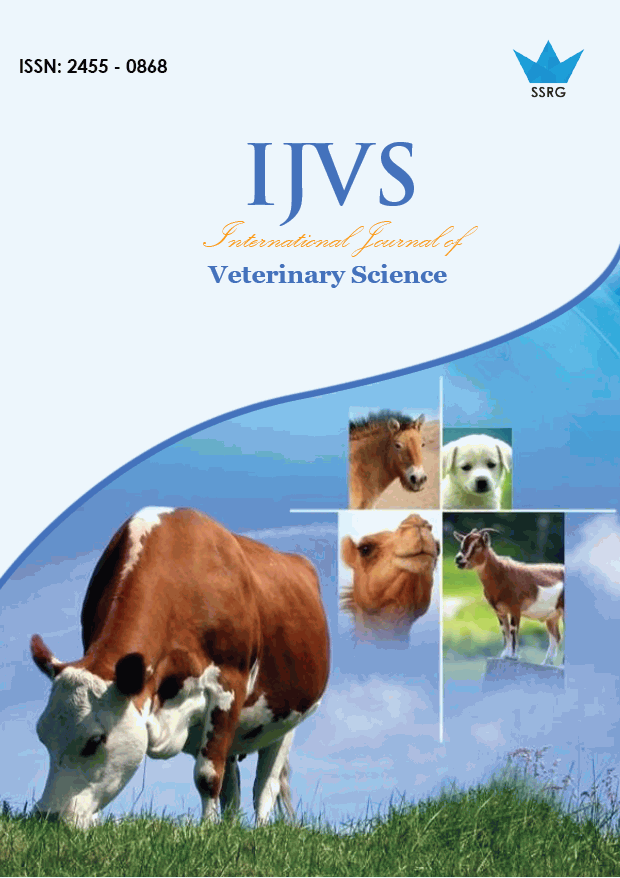Bio Compound and Physiological Transforms throughout Thermal Anxiety in Bovines

| International Journal of Veterinary Science |
| © 2015 by SSRG - IJVS Journal |
| Volume 1 Issue 1 |
| Year of Publication : 2015 |
| Authors : Dr. K.L. Basil baby |
How to Cite?
Dr. K.L. Basil baby, "Bio Compound and Physiological Transforms throughout Thermal Anxiety in Bovines," SSRG International Journal of Veterinary Science, vol. 1, no. 1, pp. 1-4, 2015. Crossref, https://doi.org/10.14445/24550868/IJVS-V1I1P101
Abstract:
Thermal stress is a major cause of production losses in the dairy and beef industries. Dairy animals are more heat sensitive as average milk yield has increased. Calves may be sold for veal, or for one of several types of beef production, depending on available local crops and markets. Such bull calves may be castrated if turnout onto pastures is envisaged, in order to render the animals less aggressive. During thermal stress physiological and biochemical changes occurs in the animal body which directly or indirectly affect the production. This review clearly describes about biochemical and physiological changes occur during thermal stress in bovines. Most dairy farms separate calves from their mothers within a day of birth to reduce transmission of disease and simplify management of milking cows.
Keywords:
Thermal anxiety; Bovines; Physiological changes; Biochemical transforms
References:
1. A.H. Ganaie, Gauri Shanker, Nazir A. Bumla, Ghasura R.S, N.A. Mir, Wani SA and Dudhatra GB, Biochemical and Physiological Changes during Thermal Stress in Bovines, J Veterinary Sci Technology 2013, 4:1, 2013.
2. Megahed GA, Anwar MM, Wasfy SI, Hammadeh ME Influence of heat stress on the cortical and oxidantantioxidants balance during oestrous phase in buffalo-cows (Bubalus bubalis): thermo-protective role of antioxidant treatment. Reprod Domest Anim 43: 672-677, 2008.
3. Rasooli A, Nouri M, Khadjeh GH, Rasekh A the influences of seasonal variations on thyroid activity and some biochemical parameters of cattle. Iranian Journal Veterinary Research, University of Shiraz 5: 1383-2004, 2004.
4. Altan O, Pabuccuoglu A, Altan A, Konyalioglu S, Bayraktar H Effect of heat stress on oxidative stress, lipid per oxidation and some stress parameters in broilers. Br Poult Sci 44: 545- 550, 2003.
5. West JW, Hill GM, Fernandez JM, Mandebvu P, Mullinix BG Effects Of Dietary Fiber On Intake, Milk Yield, And Digestion By Lactating Dairy Cows During Cool Or Hot, Humid Weather. J Dairy Sci 82: 2455-2465, 1999.
6. Nardone A, Ronchi B, Lacetera N, Ranieri MS, Bernabucci U Effects of climate changes on animal production and sustain ability of livestock systems. Livest Sci 130: 57-69, 2010.
7. Mann T, Keilin D Haemocuprin and hepatocuprin, copper protein compounds and liver in mammals. Proceedings of Royal Society of London Series B, Biological Science 126: 303-315, 1938.
8. Marai IFM, Daader AH, Abdel-Samee AM, Ibrahim H winter and summer effects and their amelioration on lactating Friesian and Holstein cows maintained under Egyptian conditions. International conference on animal, poultry and rabbit production and health. Egyptian International Center
for Agriculture, Dokki, Cairo, Egypt, 1997.
9. Koubkova M, Knizkova I, Kunc P, Hartlova H, Flusser J, et al. Influence of high environmental temperatures and evaporative cooling on some physiological, haematological and biochemical parameters in high yielding dairy cows. Czech J Anim Sci 47: 309-318, 2007.

 10.14445/24550868/IJVS-V1I1P101
10.14445/24550868/IJVS-V1I1P101